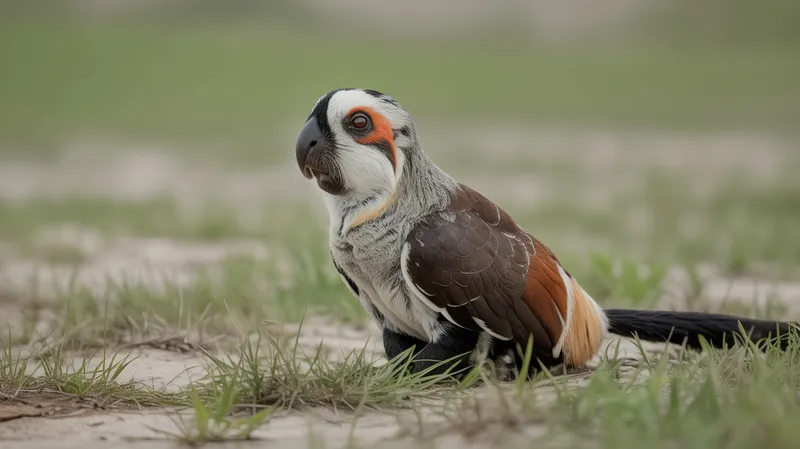
Tuco-tuco
Ctenomys talarum

Meet the Tuco-tuco
The Tuco-tuco is a small, burrowing rodent native to South America, particularly found in Argentina, Uruguay, and southern Brazil. It is named for its distinctive 'tuc-tuc' vocalizations, which it uses to communicate underground. Tuco-tucos have cylindrical bodies, short limbs, and strong claws adapted for digging extensive tunnel systems. They are solitary animals, spending most of their life underground and emerging primarily to collect plant material for food. Their fur color tends to match the soil of their habitat, providing camouflage from predators.
Classification
Mammal
Habitat
Grasslands and sandy coastal plains
Diet
Herbivore
Lifespan
2-5 years
Conservation
Least Concern
Weight
120-300 grams
📖Fascinating Facts
Expert Diggers
Tuco-tucos are master tunnelers, constructing elaborate underground burrow networks that protect them from predators and extreme temperatures.
Vocal Communication
They communicate using repetitive 'tuc-tuc' sounds, which travel well through their subterranean habitats and help maintain territory boundaries.
Herbivorous Diet
Tuco-tucos feed primarily on roots, grasses, and seeds, collecting and storing food in underground chambers.
📋Detailed Description
The tuco-tuco (Ctenomys talarum) is a medium-sized subterranean rodent, typically measuring 16–22 cm in head-body length and weighing between 120–250 grams. Its body is cylindrical with short, robust limbs and large, curved claws on the forefeet, highly specialized for digging. The fur is dense, soft, and varies from grayish-brown to sandy, closely matching the color of the local soil, which provides camouflage against predators when above ground. The skull is broad and flattened, with powerful jaw muscles and ever-growing incisors adapted for gnawing roots and tubers. Tuco-tucos possess small eyes and ears, reflecting their primarily fossorial (burrowing) lifestyle. Their vibrissae (whiskers) are well-developed, aiding navigation in dark tunnels. They construct extensive tunnel systems, sometimes exceeding 30 meters in length, with multiple chambers for nesting, food storage, and waste. Solitary by nature, each individual maintains and defends its own burrow system, using vocalizations and scent marking to communicate territory boundaries. Their activity is largely crepuscular, with peak foraging occurring during early morning and late afternoon.
💡 Did you know?
Unlike many rodents, some tuco-tuco species have one of the highest rates of chromosomal variation among mammals.
🔬Research & Sources
Wikipedia Summary
A tuco-tuco is a neotropical rodent in the family Ctenomyidae. Tuco-tucos belong to the only living genus of the family Ctenomyidae, Ctenomys, but they include approximately 60 different species. The common name, "tuco-tuco", comes from the "tuc-tuc" sound they make while they dig their burrows.
Last Modified: 6/9/2025
🎭Behavior & Social Structure
Tuco-tucos are predominantly solitary and territorial, rarely tolerating conspecifics within their burrow systems except during the breeding season. They are herbivorous, feeding mainly on underground plant parts such as roots, bulbs, and rhizomes, but will also consume above-ground grasses and leaves when available. Foraging is typically done close to the burrow entrance, minimizing exposure to predators. They exhibit food hoarding behavior, transporting plant material in their cheek pouches to underground storage chambers. Communication is achieved through a combination of vocalizations (the characteristic 'tuc-tuc' calls), foot-drumming, and scent marking. Aggressive encounters between neighbors involve vocal displays and, if escalated, physical combat. Daily routines are structured around periods of digging, foraging, and resting within the nest chamber. Above-ground activity is rare and brief, as tuco-tucos are vulnerable to avian and terrestrial predators.
👶Reproduction & Life Cycle
Breeding in Ctenomys talarum is seasonal, typically occurring from late winter to early summer (August to January in the southern hemisphere). Males expand their home ranges during this period in search of receptive females. Courtship involves vocalizations and scent marking. After mating, gestation lasts approximately 90 days. Females give birth to litters of 2–5 altricial young in a specially constructed nesting chamber lined with plant material. The young are born blind and hairless, opening their eyes after about 10 days and weaning at 3–4 weeks. Parental care is provided solely by the mother, who remains highly protective and aggressive toward intruders. Juveniles disperse from the natal burrow at 4–6 weeks of age to establish their own territories.
🛡️Adaptations & Survival
Ctenomys talarum exhibits a suite of adaptations for a fossorial lifestyle. Morphologically, it has powerful forelimbs with enlarged claws for efficient digging, a compact body to navigate narrow tunnels, and reduced external pinnae to prevent soil ingress. Its incisors are procumbent and robust, allowing it to excavate soil with its teeth as well as its claws. The fur is short and dense, minimizing friction and protecting the skin from abrasion. Physiologically, tuco-tucos have a low metabolic rate and efficient water conservation mechanisms, enabling survival in arid, sandy environments. Behaviorally, their solitary and territorial nature reduces intraspecific competition for limited underground resources. Their vocalizations are adapted for transmission through soil and tunnels, facilitating long-distance communication underground.
📚Research Sources
🎨Cultural Significance
Tuco-tucos are well known in South American folklore for their distinctive underground calls, which are often associated with omens or the presence of hidden water sources. In rural Argentina, their burrowing activity is sometimes interpreted as a sign of soil fertility. While not commonly hunted or used for food, they occasionally appear in local myths and children's stories as industrious or secretive creatures. Their ecological role as ecosystem engineers—modifying soil structure and promoting plant diversity—is increasingly recognized in conservation and land management discussions.
🔬Recent Research & Discoveries
Recent genetic and cytogenetic studies have revealed remarkable chromosomal diversity within the genus Ctenomys, with C. talarum populations exhibiting significant karyotypic variation (2n = 46–48). This has made the group a model system for studying speciation, chromosomal evolution, and adaptation to subterranean life. Ongoing research is investigating the physiological adaptations of tuco-tucos to hypoxic (low-oxygen) underground environments, including their hemoglobin function and metabolic rates. Behavioral studies using acoustic monitoring have provided new insights into their communication systems and territoriality. Conservation genetics projects are assessing the impact of habitat fragmentation on gene flow and population viability.
🎥Wildlife Videos

Tuco-Tuco 🦫 Their Secret Burrow Life! | 1 Minute Animals
These pint-sized South American rodents are like nature's bulldozers, crafting intricate tunnels beneath the Earth. They're ...
1 Minute Animals

Tuco-Tucos, a subterranean society
Documentary which narrates the research work of Eileen Lacey and her collaborators, aimed at knowing the sociability of a ...
Timbó Films

The Unique Wildlife of Brazil’s Rainforest
Explore the incredible biodiversity and unique ecosystems of Brazil's Mata Atlântica and other regions. The show delves into the ...
Real Wild

Wild Canada - Nature's Untamed Beauty | Full Series | Free Documentary Nature
Wild Canada - Nature's Untamed Beauty | Wildlife Documentary Watch 'Darkwoods - Canada's Hidden Nature Reserve' here: ...
Free Documentary - Nature

The Baltic | Survival in a Pristine Ecosystem | Animal documentary
Welcome to "The Baltic | Survival in a Pristine Ecosystem", a captivating wildlife documentary that transports you to the serene yet ...
WILD NATURE - Nature animal documentary

Wildlife Stories: Love is in the Wild | SPECIAL | Free Documentary Nature
Wildlife Stories: Love is in the Wild | Special | Free Documentary Nature Watch 'Wildlife Stories: Talking to Survive' here: ...
Free Documentary - Nature
🌍Habitat Information
The Tuco-tuco typically inhabits Grasslands and sandy coastal plains environments. Tuco-tucos have adapted to their environments with specialized features and behaviors.
Primary Habitat:
Grasslands and sandy coastal plains
More detailed habitat information will be available soon.
🛡️Conservation Status
The Tuco-tuco is currently classified as Least Concern. Conservation efforts are crucial for preserving this species for future generations.
Common Threats:
- 🏠Habitat loss and fragmentation
- 🌡️Climate change impacts
- 🎯Hunting and poaching
- 🏭Human-wildlife conflict
⚠️Threats & Conservation Challenges
Although Ctenomys talarum is currently classified as Least Concern by the IUCN, localized populations face threats from habitat loss due to agricultural expansion, urbanization, and afforestation with non-native species. Soil compaction from livestock and machinery can destroy burrow systems and reduce suitable habitat. They are also subject to predation by birds of prey, foxes, and snakes. Fragmentation of populations may lead to reduced genetic diversity and increased vulnerability to environmental changes. In some areas, tuco-tucos are considered agricultural pests due to their burrowing and foraging activities, leading to persecution by farmers.
🔬Scientific Classification
Scientific Name
Ctenomys talarum
Classification Hierarchy
🔍 About Taxonomic Classification
Taxonomic classification is a hierarchical system used by scientists to classify and organize living organisms based on shared characteristics and evolutionary relationships.
The system moves from broad categories (Kingdom) to increasingly specific ones, with each animal's scientific name typically consisting of its Genus and species.
📝Community Notes
Share your observations and insights about the Tuco-tuco with our community of wildlife enthusiasts.
Join Our Community
Sign in to share your observations and connect with fellow wildlife enthusiasts.
Sign In to ContributeNo community notes yet
Be the first to share your observations about the Tuco-tuco!
Explore Tuco-tuco
Select a tab above to learn more about this amazing animal.
📸Photo Gallery
No photos available for this animal yet.
🌟Discover More Wildlife
Continue your journey of discovery with more fascinating animals from our database
